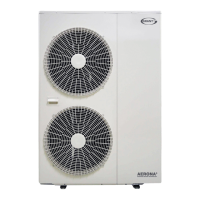Section 3: Installation InformationPage 12
3.6 Installing the Heat Pump
3.6.1 Insulation
The complete water circuit, including all pipework, must be insulated
to prevent heat loss reducing the efficiency of the heat pump and also
to prevent damage due to frozen pipes.
3.6.2 Connecting the Heating System to the Heat Pump
• Water connections must be made in accordance with diagram in
this manual and the labels on the heat pump.
• Be careful not to deform the heat pump pipework by using
excessive force when connecting.
• Pipework should be flushed before connecting the heat pump.
• Hold the pipe end downwards when removing burrs.
• Cover the pipe end when inserting it through a wall so that no
dust and dirt enter.
• The heat pump is only to be used in a sealed heating
system. It must not be used as part of an open-vented
system.
Before continuing the installation of the heat pump, check the
following points:
• The maximum system water pressure is 3 bar.
• Make sure the hose is connected to the pressure relief valve to
avoid any water coming into contact with electrical parts.
• Air vents must be provided at all high points of the system. The
vents should be located at points which are easily accessible
for servicing. An automatic air purge valve is provided inside the
heat pump. Check that the air purge valve can operate.
• Take care that the components installed in the pipework can
withstand the water pressure.
3.6.3 System Connections
The system connections of the heat pump must be carried out using
the flexible hoses, valves and fittings supplied with the heat pump.
The hydraulic circuit must be completed following the
recommendations below:
1. It is important to install the isolation valves between the heat
pump and the building.
2. The system must have drain cocks in the lowest points.
3. Air vents must be included at the highest points of the system.
4. A system pressure gauge must be installed upstream of the heat
pump.
5. All pipework must be adequately insulated and supported.
6. The presence of solid particles in the water can obstruct the
heat exchanger. Therefore, protect the heat exchanger using a
magnetic filter such as a Grant Mag-One.
7. After system assembly flush and clean the whole system, paying
particular attention to the state of the filter.
8. A new installation must be thoroughly flushed and cleaned before
filling and adding anti-freeze/biocide/inhibitor.
Do not use the heat pump to treat industrial process water,
swimming pool water or domestic drinking water. Install an
intermediate heat exchanger for all of the above cases.
!
WARNING
3.6.4 Remote Controller
For details on how to install the remote controller, refer to Section 7.
For setting, refer to Section 9.
3.7 Metering for Domestic RHI Installations
Some air source heat pump installations may require a heat meter to
be fitted under certain circumstances, for example:
• Where the property is occupied for less than 183 days per year
• If there is a back-up heating system installed
A heat meter must be installed and regular meter readings will have
to be submitted as the RHI payment will be determined from these
readings.
‘Meter Ready’ Installations
Currently, air source heat pump installations that are receiving a
domestic Renewable Heat Incentive (RHI) payment will not usually
require a heat meter to be fitted. The payment is based on the annual
heat demand, as stated on the EPC for the property.
However, even though a heat meter is not required for these
domestic installations to receive an RHI, they must be ‘meter ready’
in accordance with MCS requirements. Refer to the MCS Domestic
RHI Metering Guidance Document for full details.
3.8 Buffer Tanks
3.8.1 Buffer Tanks
A buffer tank is NOT required for the Grant Aerona³ HPID6 (6kW) and
HPID10 (10kW) heat pumps.
A buffer tank will be required for the Grant Aerona³ HPID16 (16kW)
heat pump where:
• The overall system volume is less than 100litres
OR
• If the part of the system connected to the heat pump is less than
30 litres during the normal operation of the system
For example:
• When the heating zone valves(s) are closed leaving only the
primary circuit to a cylinder connected to the heat pump
• When the hot water zone valve is closed leaving a heating zone
(or zones) connected to the heat pump
The buffer tank must be large enough to ensure that the volume of
that part of the system will be at least 30 litres.
This buffer tank is simply a vessel required to increase the volume of
the system, to meet the requirements given above. It must be fitted in
the return to the heat pump. Refer to Figure 3-4.
Buffer tanks suitable for this purpose are available. For further
information, please contact Grant UK on +44 (0)1380 736920.
A buffer tank temperature probe is NOT required as this is not
a thermal store.
NOTE
!

